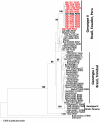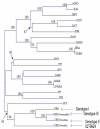Iquitos virus: a novel reassortant Orthobunyavirus associated with human illness in Peru
- PMID: 21949892
- PMCID: PMC3176741
- DOI: 10.1371/journal.pntd.0001315
Iquitos virus: a novel reassortant Orthobunyavirus associated with human illness in Peru
Abstract
Oropouche (ORO) virus, a member of the Simbu serogroup, is one of the few human pathogens in the Orthobunyavirus genus in the family Bunyaviridae. Genetic analyses of ORO-like strains from Iquitos, Peru, identified a novel reassortant containing the S and L segments of ORO virus and the M segment of a novel Simbu serogroup virus. This new pathogen, which we named Iquitos (IQT) virus, was first isolated during 1999 from a febrile patient in Iquitos, an Amazonian city in Peru. Subsequently, the virus was identified as the cause of outbreaks of "Oropouche fever" during 2005 and 2006 in Iquitos. In addition to the identification of 17 isolates of IQT virus between 1999 and 2006, surveys for neutralizing antibody among Iquitos residents revealed prevalence rates of 14.9% for ORO virus and 15.4% for IQT virus. Limited studies indicate that prior infection with ORO virus does not seem to protect against disease caused with the IQT virus infection. Identification of a new Orthobunyavirus human pathogen in the Amazon region of Peru highlights the need for strengthening surveillance activities and laboratory capabilities, and investigating the emergence of new pathogens in tropical regions of South America.
Conflict of interest statement
The authors have declared that no competing interests exist.
Figures



References
-
- Grimstad PR. California group virus disease. In: Monath TP, editor. The Arboviruses: Epidemiology and Ecology. Boca Raton, FL: CRC Press; 1988. pp. 99–136.
-
- Gonzales JP, Georges, J A. Bunyaviral fevers: Bunyamwera, Ilesha, Germiston, Bwamba and Tataguine. In: Monath TP, editor. The Arboviruses: Epidemiology and Ecology Boca Raton, FL: CRC Press; 1988. pp. 87–98.
-
- Bowen MD, Trappier SG, Sanchez AJ, Meyer RF, Goldsmith CS, et al. A reassortant bunyavirus isolated from acute hemorrhagic fever cases in Kenya and Somalia. Virology. 2001;291:185–190. - PubMed
Publication types
MeSH terms
Substances
Grants and funding
LinkOut - more resources
Full Text Sources
Molecular Biology Databases

